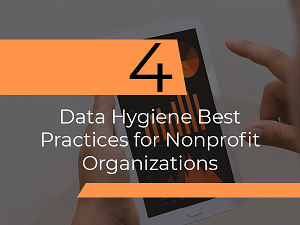
As a nonprofit professional, you understand the importance of data. Whether you’re reaching out to donors, updating your social media marketing strategy, or recruiting volunteers, a comprehensive database likely guides your decision-making.
However, data is only helpful if it’s clean; that’s where data hygiene comes into play.
Data hygiene is the process of removing inaccurate information from your database, updating outdated information, and merging duplicate entries.
With clean data, you can make better-informed decisions that help you achieve your goals.
To help you get started with data hygiene, we’ve compiled a list of four best practices. Let’s dive in!
1. Start with an audit.
The first step in ensuring good data hygiene is to conduct an audit of your database. An audit allows you to analyze your donor data in greater detail and identify any areas that need improvement.
Follow these steps to conduct a database audit:
- Determine your goals. If you’re hoping to clean up your data, chances are that you have a data-backed initiative in mind. Creating actionable goals will provide focus to your audit. For example, if you’re looking to thank the donors who contributed to your recent fundraising campaign, make sure your donor contact information and communication preferences are up to date.
- Collect data from all storage methods. Consolidating all of your data in your database will make it easier to find and access. This may entail gathering data from various spreadsheets and physical forms.
- Seek out inaccurate or unnecessary information. Once your data is in the same place, you can start to identify any inaccuracies. Note any entries that need to be removed or updated, and determine how much time will be needed to resolve each issue.
- Inform your team. After you conduct an audit, tell your team what you’ve found and create a plan for how you will rectify the issues. You may want to consult with your board about next steps, especially if they involve outsourcing the data hygiene process.
While auditing your database can be time-consuming, it’s worth taking the time to determine the major problem areas in your data and create a plan to rectify them. That way, you can more easily reach your supporters using updated, accurate information.
2. Remove inaccurate and unnecessary information.
After conducting an audit of your database, remove any data marked as unnecessary. Getting rid of irrelevant and inaccurate data points ensures that you’re directing your funds and marketing materials to the right people.
Keep the following tips in mind as you resolve inaccuracies:
- delete data from minors, deceased supporters, and people on “do not call” or “do not mail” lists;
- identify any outdated or incorrect email addresses with an email scrubbing tool; and,
- merge any duplicate records to clear up confusion.
Then, use these updated metrics to segment and personalize outreach. Kwala’s guide to donor communications recommends segmenting donors based on donation frequency, size, or type to improve the donor experience and more effectively target each group.
3. Append missing data.
Cleaning up your data may reveal gaps where additional information is needed. For example, when running a capital campaign, you’ll want to ensure that donor prospects have the financial capacity to give. In that case, you would need to know their net worth, which you could source through a data append.
AccuData describes data appending as the process of supplementing your current database with information from third-party sources. There are several different types of data you can append, including:
- phone numbers;
- social media handles;
- email addresses;
- net worth;
- employment status; and,
- giving history.
Partnering with a data provider for data appends can ensure that you’re rounding out your database with accurate information. To fund the partnership, consider tapping into your marketing budget.
4. Make data hygiene an ongoing process.
When you make data hygiene a priority, you can avoid the need for major cleanses and prevent issues altogether.
Creating a standardized data hygiene process will save your team time and energy in the future. We recommend implementing the following practices into your data hygiene routine:
- Standardize data input. Establish data input rules for your team. These could include certain regulations for entering phone numbers, emails, addresses, and title abbreviations to prevent confusion later on. For example, you may want your team to use parentheses around the numbers in a phone number area code instead of dashes.
- Get your team up to speed. Data hygiene is a team effort. Host training sessions so team members know exactly how to enter, clean, and analyze the data in your database.
- Reconsider the information you request from supporters. When you performed your database audit, you may have noticed some extraneous information that your organization no longer needs. To avoid having to continually remove this data, only ask supporters for essential information, such as their names, contact information, and communication preferences.
When you regularly review and update your database, you can speed up the data hygiene process and better engage supporters in the long run. Additionally, standardized practices make it easy to continue your data hygiene routine amid personnel changes or other potential disruptions.
With a comprehensive data hygiene strategy in place, you can optimize your fundraising efforts, improve communication with donors and volunteers, and achieve your mission with greater efficiency. Remember to remain vigilant and resolve data-related issues as they arise, rather than allowing them to pile up. Doing so will help you make a greater impact on the communities you serve.
- Conduct a database audit to identify any problem areas.
- Remove any unnecessary or inaccurate data.
- Consider working with a data provider to append missing data.
- Standardize the data hygiene process for your team.